Tidal Bore Scour around a Spur Dike
Abstract
:1. Introduction
2. Materials and Methods
2.1. Study Site
2.2. Field Observation
2.3. Experiment Description
3. Results and Discussions
3.1. Flow Structure around the Spur Dike
3.2. Scour Holes around the Spur Dikes
3.3. Model Test Results
3.4. Dimensional Analysis of the Scour Depth
- (1)
- The variables describing the spur dike and riverbed geometry are the distance (d) from the main channel to the seawall, the effective length (l) of the spur dike, and the spur dike angle (θ);
- (2)
- The variables describing water flow are the tidal bore height (H), velocity (U), and characteristic water depth (h), which can be selected by the water depth of the low tide level;
- (3)
- The variables describing the fluid are the gravitational acceleration (g), the volume weight of the water (γ), and the dynamic viscosity of the water (υ);
- (4)
- The variables describing sediment are the median particle size (D), bulk density difference in water (Δγs), and suspended sediment concentration (S).
3.5. Fitting Formula Verification
4. Conclusions
Author Contributions
Funding
Institutional Review Board Statement
Informed Consent Statement
Data Availability Statement
Conflicts of Interest
References
- Chanson, H. Tidal Bores, Aegir, Eagre, Mascaret, Pororoca Theory and Observations; World Scientific: Singapore, 2012. [Google Scholar]
- Filippini, A.G.; Arpaia, L.; Bonneton, P.; Ricchiuto, M. Modeling analysis of tidal bore formation in convergent estuaries. Eur. J. Mech. B Fluids 2019, 73, 55–68. [Google Scholar] [CrossRef]
- Li, Y.; Pan, D.; Cheng, W.; Pan, C. Tidal stream energy resource assessment in the Qiantang River Estuary, China. Int. J. Sustain. Energy 2018, 37, 704–717. [Google Scholar] [CrossRef]
- Li, Y.; Pan, D.; Chanson, H.; Pan, C. Real-time characteristics of tidal bore propagation in the Qiantang River Estuary, China, recorded by marine radar. Cont. Shelf Res. 2019, 180, 48–58. [Google Scholar] [CrossRef] [Green Version]
- Pan, D.; Li, Y.; Pan, C. Historical and projected future trends of tidal disasters at the Qiantang River Estuary, China. J. Coast. Res. 2020, 115(SI), 682–686. [Google Scholar] [CrossRef]
- Hung, N.T.; Duc, D.M.; Quynh, D.T.; Cuong, V.D. Nearshore topographical changes and coastal stability in Nam Dinh Province, Vietnam. J. Mar. Sci. Eng. 2020, 8, 755. [Google Scholar] [CrossRef]
- Formentin, S.M. Key performance indicators for the upgrade of existing coastal defense structures. J. Mar. Sci. Eng. 2021, 9, 994. [Google Scholar] [CrossRef]
- Yossef, M.F.M.; de Vriend, H.J. Sediment exchange between a river and its groyne fields: Mobile-bed experiment. J. Hydraul. Eng. 2010, 136, 610–625. [Google Scholar] [CrossRef]
- Xiang, K.; Yang, Z.; Wu, S.; Gao, W.; Li, D.; Li, Q. Flow hydrodynamics of the mixing layer in consecutive vegetated groyne fields. Phys. Fluids 2020, 32, 065110. [Google Scholar] [CrossRef]
- Alsawaf, M.; Ghazali, A.H.; Mohammad, T.A.; Ab Ghani, A.; Yusuf, B. Movable-bed experiments using spur dike to concentrate flow in one channel of multithreaded channel model. J. Hydraul. Eng. 2019, 145, 06019006. [Google Scholar] [CrossRef]
- Elawady, E.; Michiue, M.; Hinokidani, O. Movable bed scour around submerged spur-dikes. JSCE Annu. J. Hydraul. Eng. 2001, 45, 373–378. [Google Scholar] [CrossRef] [Green Version]
- Ezzeldin, R.M. Numerical and experimental investigation for the effect of permeability of spur dikes on local scour. J. Hydroinformatics 2019, 21, 335–342. [Google Scholar] [CrossRef]
- Ozyaman, C.; Yerdelen, C.; Eris, E.; Daneshfaraz, R. Experimental investigation of scouring around a single spur under clear water conditions. Water Supply 2022, 22, 3484–3497. [Google Scholar] [CrossRef]
- Choufu, L.; Abbasi, S.; Pourshahbaz, H.; Taghvaei, P.; Tfwala, S. Investigation of flow, erosion, and sedimentation pattern around varied groynes under different hydraulic and geometric conditions: A numerical study. Water 2019, 11, 235. [Google Scholar] [CrossRef] [Green Version]
- Bahrami-Yarahmadi, M.; Pagliara, S.; Yabarehpour, E.; Najafi, N. Study of scour and flow patterns around triangular-shaped spur dikes. KSCE J. Civ. Eng. 2020, 24, 3279–3288. [Google Scholar] [CrossRef]
- Vaghefi, M.; Radan, P.; Akbari, M. Flow pattern around attractive, vertical, and repelling T-shaped spur dikes in a mild bend using CFD modeling. Int. J. Civ. Eng. 2019, 17, 607–617. [Google Scholar] [CrossRef]
- Karami, H.; Basser, H.; Ardeshir, A.; Hosseini, S.H. Verification of numerical study of scour around spur dikes using experimental data. Water Environ. J. 2014, 28, 124–134. [Google Scholar] [CrossRef]
- Zhang, L.; Wang, P.; Yang, W.; Zuo, W.; Gu, X.; Yang, X. Geometric characteristics of spur dike scour under clear-water scour conditions. Water 2018, 10, 680. [Google Scholar] [CrossRef] [Green Version]
- Atarodi, A.; Karami, H.; Ardeshir, A.; Hosseini, K.; Lampert, D. Experimental investigation of scour reduction around spur dikes by collar using Taguchi method. IJST-T Civ. Eng. 2021, 45, 971–983. [Google Scholar] [CrossRef]
- Wu, T.; Qin, J. Influence of flow and sediment transport processes on sedimentation in groyne fields. J. Coast. Res. 2020, 95(SI), 304–308. [Google Scholar] [CrossRef]
- Pandey, M.; Ahmad, Z.; Sharma, P.K. Scour around impermeable spur dikes: A review. ISH J. Hydraul. Eng. 2018, 24, 25–44. [Google Scholar] [CrossRef]
- Bigham, K.A. Streambank stabilization design, research, and monitoring: The current state and future needs. Trans. ASABE 2020, 63, 351–387. [Google Scholar] [CrossRef]
- Koken, M.; Gogus, M. Effect of spur dike length on the horseshoe vortex system and the bed shear stress distribution. J. Hydraul. Res. 2015, 53, 196–206. [Google Scholar] [CrossRef]
- Malik, S.; Pal, S.C. Is the construction of groynes accelerating the degradation of channel morphology and paved the way for human encroachment in The Bengal Basin? Adv. Space Res. 2019, 64, 1549–1576. [Google Scholar] [CrossRef]
- Chanson, H. Undular tidal bores: Effect of channel constriction and bridge piers. Environ. Fluid Mech. 2011, 11, 385–404. [Google Scholar] [CrossRef]
- Li, Y.; Pan, D.; Chanson, H.; Pan, C. Tidal bore progressing on a small slope. Exp. Therm. Fluid Sci. 2017, 88, 513–518. [Google Scholar] [CrossRef] [Green Version]
- Xu, C.; Yin, M.; Pan, X. Field test and numerical simulation of tidal bore pressures on sheet-pile groin in Qiantang River. Mar. Georesources Geotechnol. 2016, 34, 303–312. [Google Scholar] [CrossRef]
- Cai, Y.; Cao, Z.; Wang, U.; Guo, Z.; Chen, R. Experimental and numerical study of the tidal bore impact on a newly developed sheet-pile groin in Qiantang river. Appl. Ocean Res. 2018, 81, 106–115. [Google Scholar] [CrossRef]
- Pan, D.; Li, Y.; Pan, C. Short-term morphological responses of adjacent intertidal flats to the construction of tidal gates in an estuarine tributary. J. Mar. Sci. Eng. 2022, 10, 882. [Google Scholar] [CrossRef]
- Kamphuis, J.W. Physical modeling of coastal processes. In Advance in Coastal and Ocean Engineering; Liu, P.L., Ed.; World Scientific: Singapore, 1996. [Google Scholar]
- Pandey, M.; Valyrakis, M.; Qi, M.; Sharma, A.; Lodhi, A.S. Experimental assessment and prediction of temporal scour depth around a spur dike. Int. J. Sediment Res. 2021, 36, 17–28. [Google Scholar] [CrossRef]
- Pandey, M.; Jamei, M.; Karbasi, M.; Ahmadianfar, I.; Chu, X. Prediction of maximum scour depth near spur dikes in uniform bed sediment using stacked generalization ensemble tree-based frameworks. J. Irrig. Drain. Eng. 2021, 147, 04021050. [Google Scholar] [CrossRef]
- Dou, G. Incipient motion of sediment under currents. China Ocean Eng. 2000, 14, 391–406. [Google Scholar]
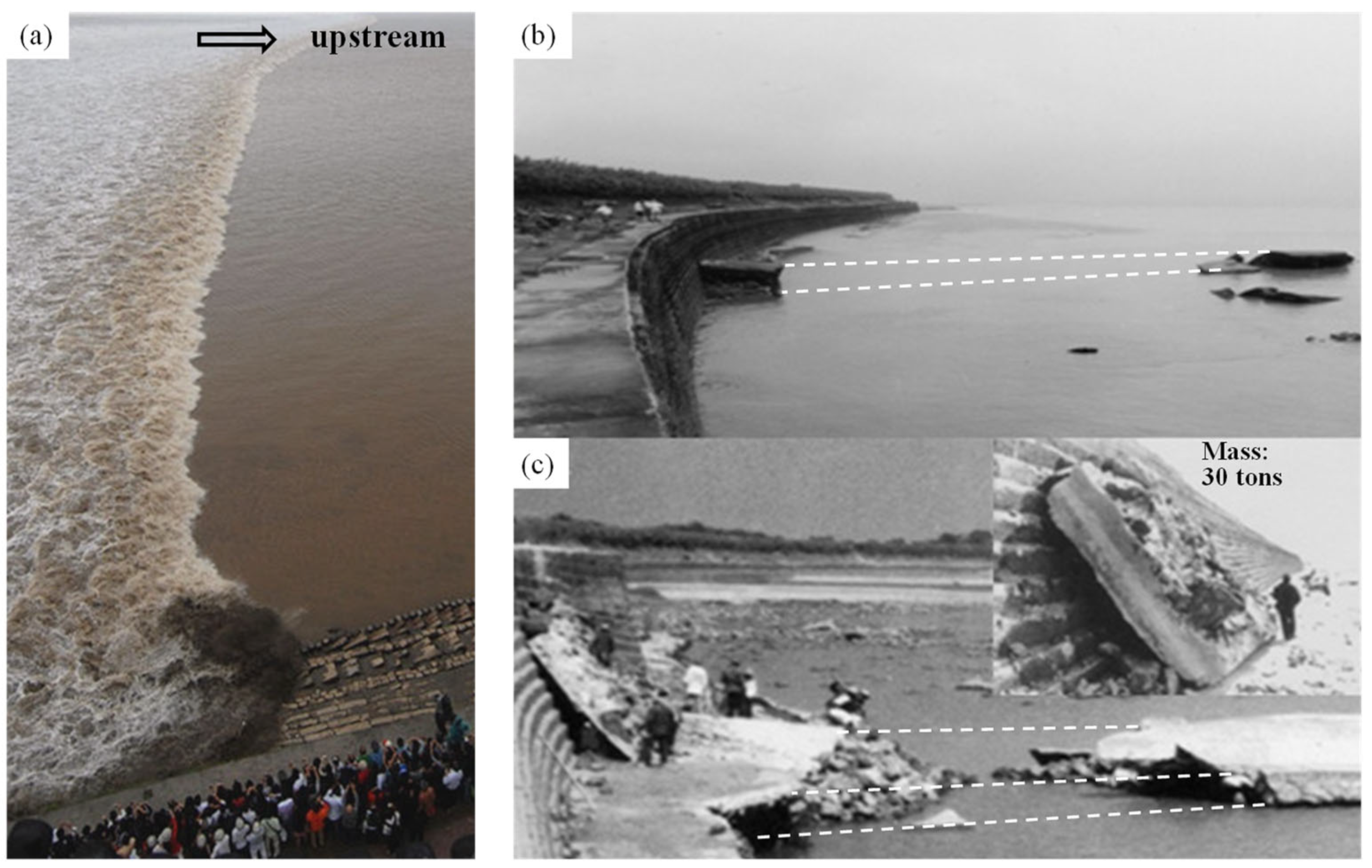
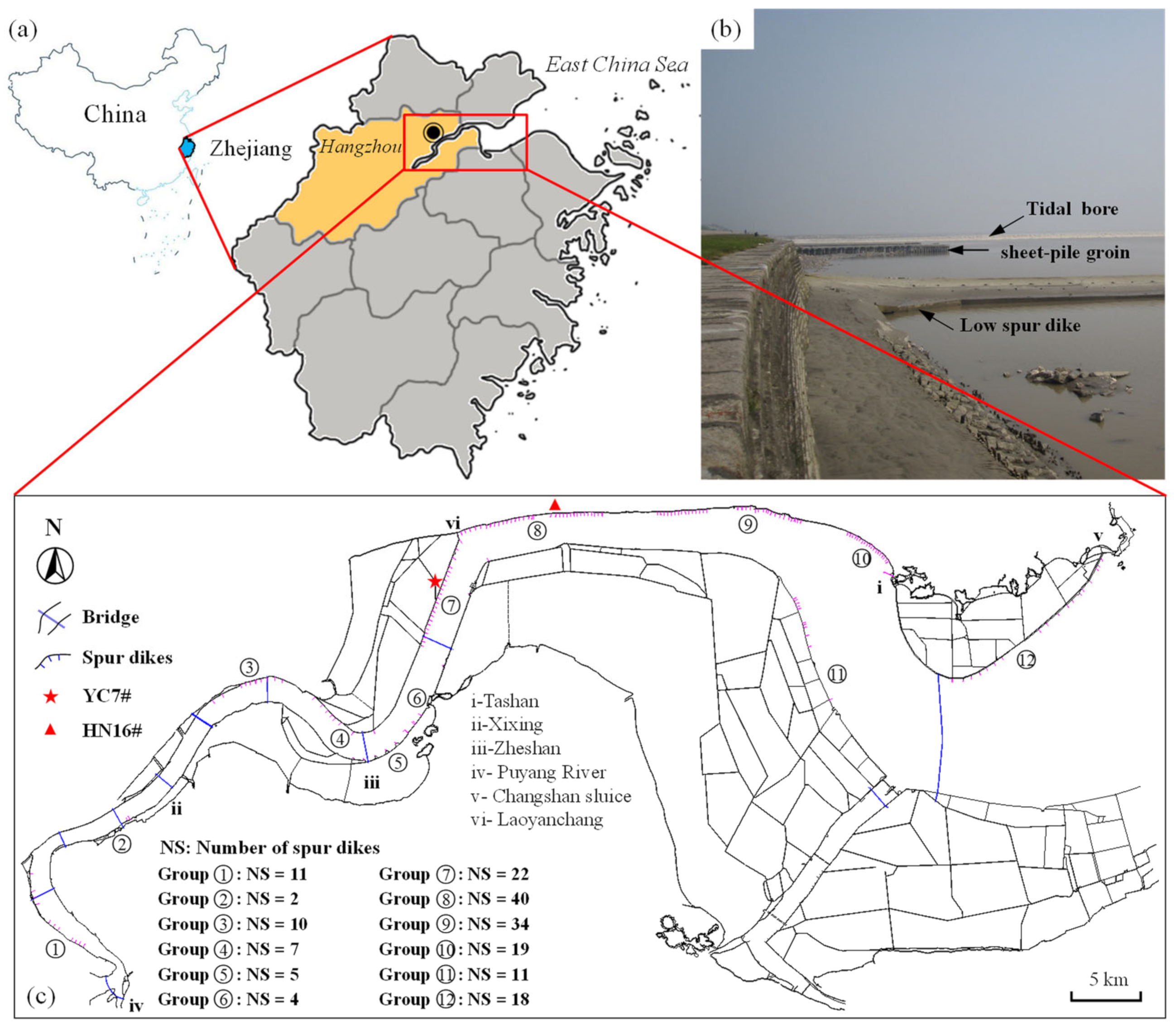
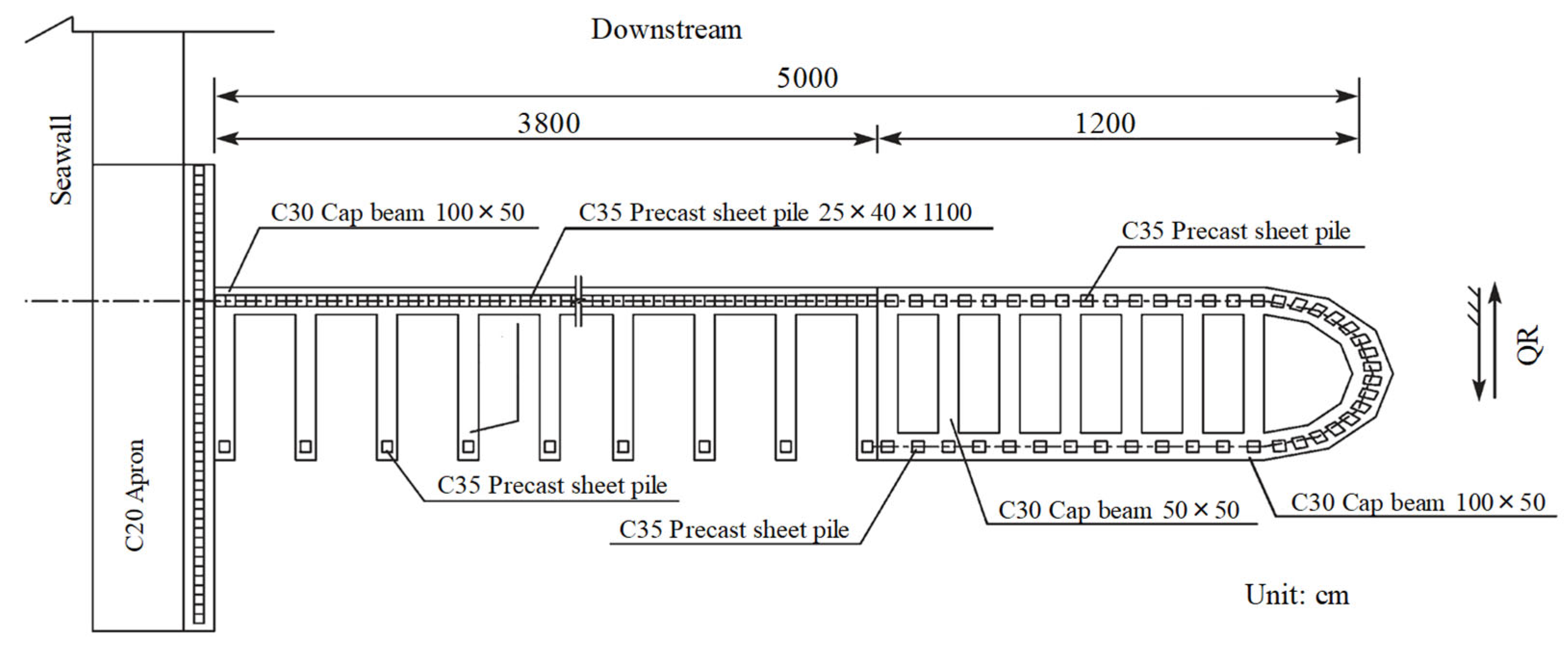
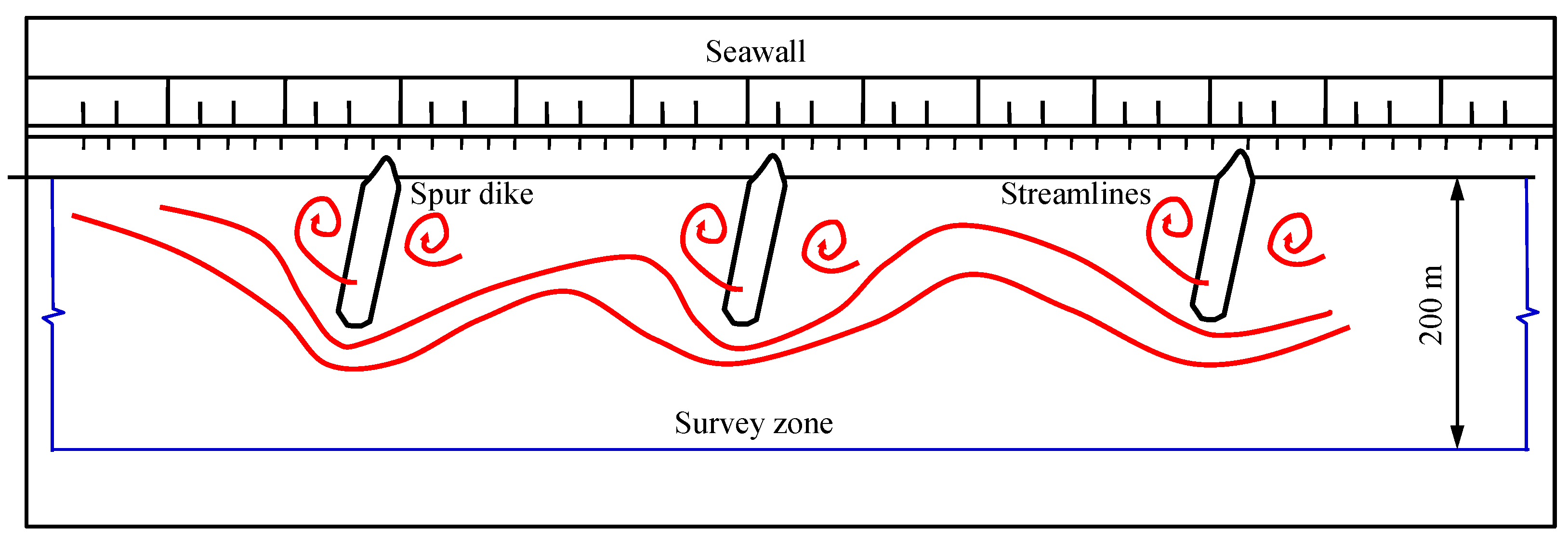
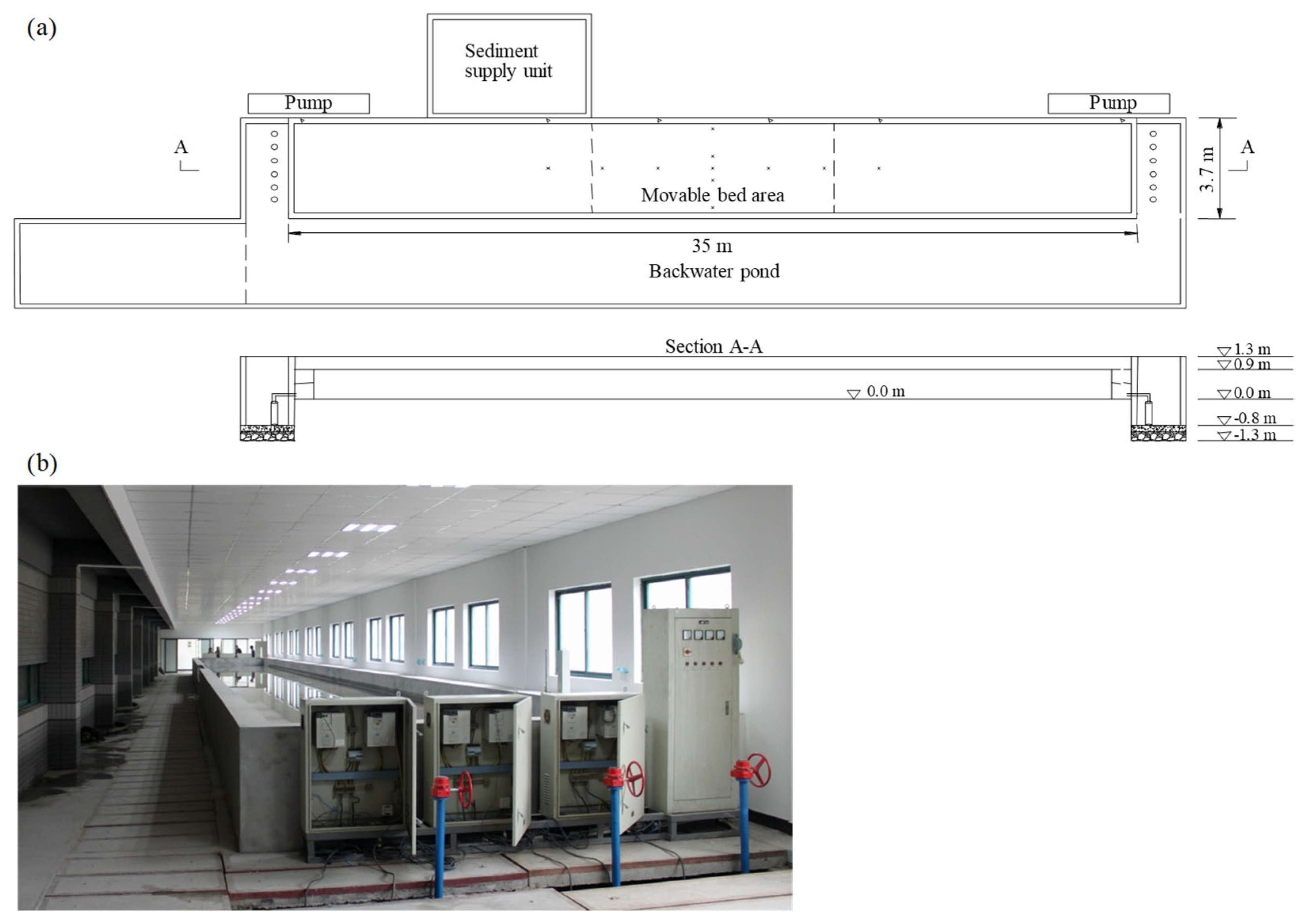
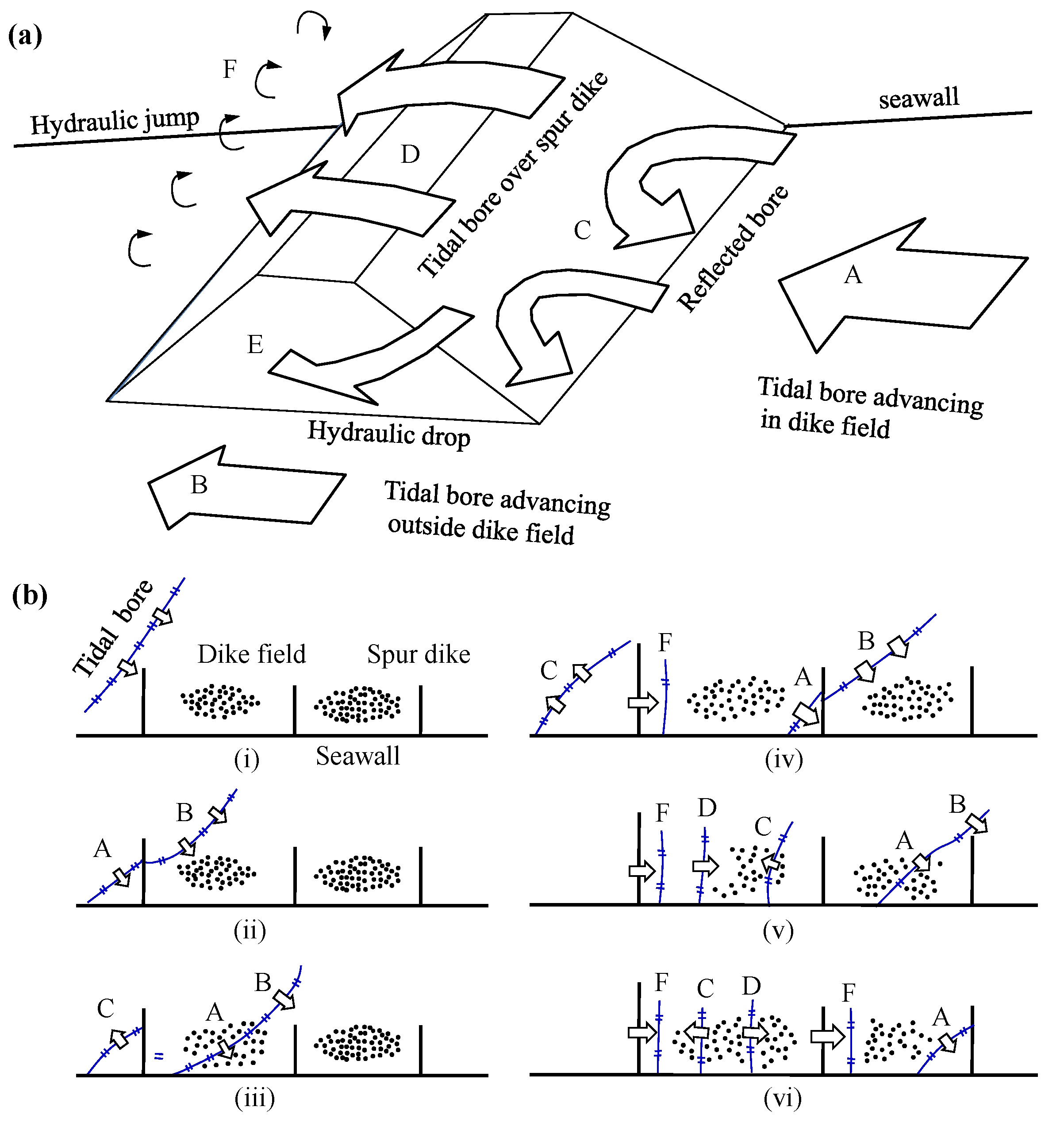
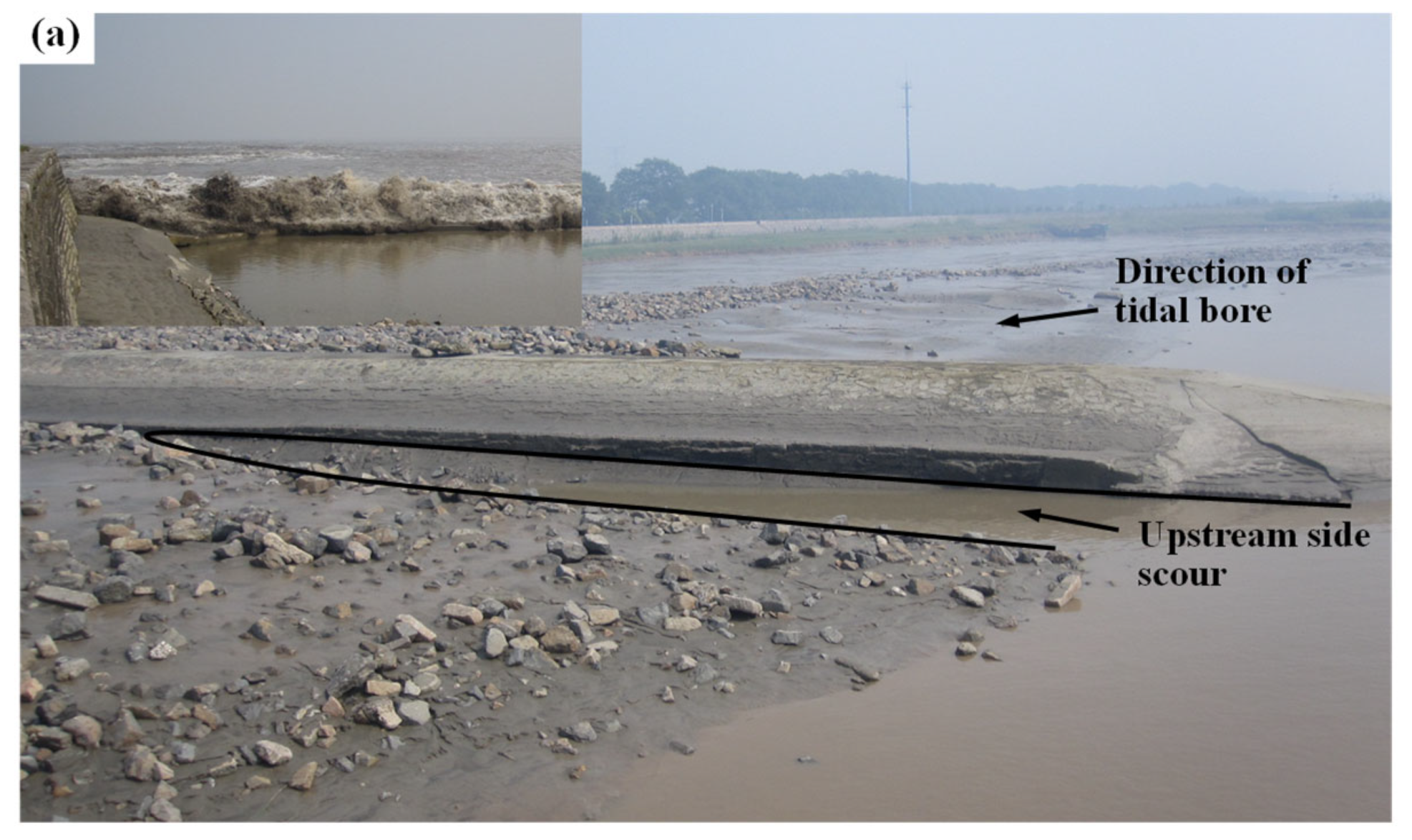

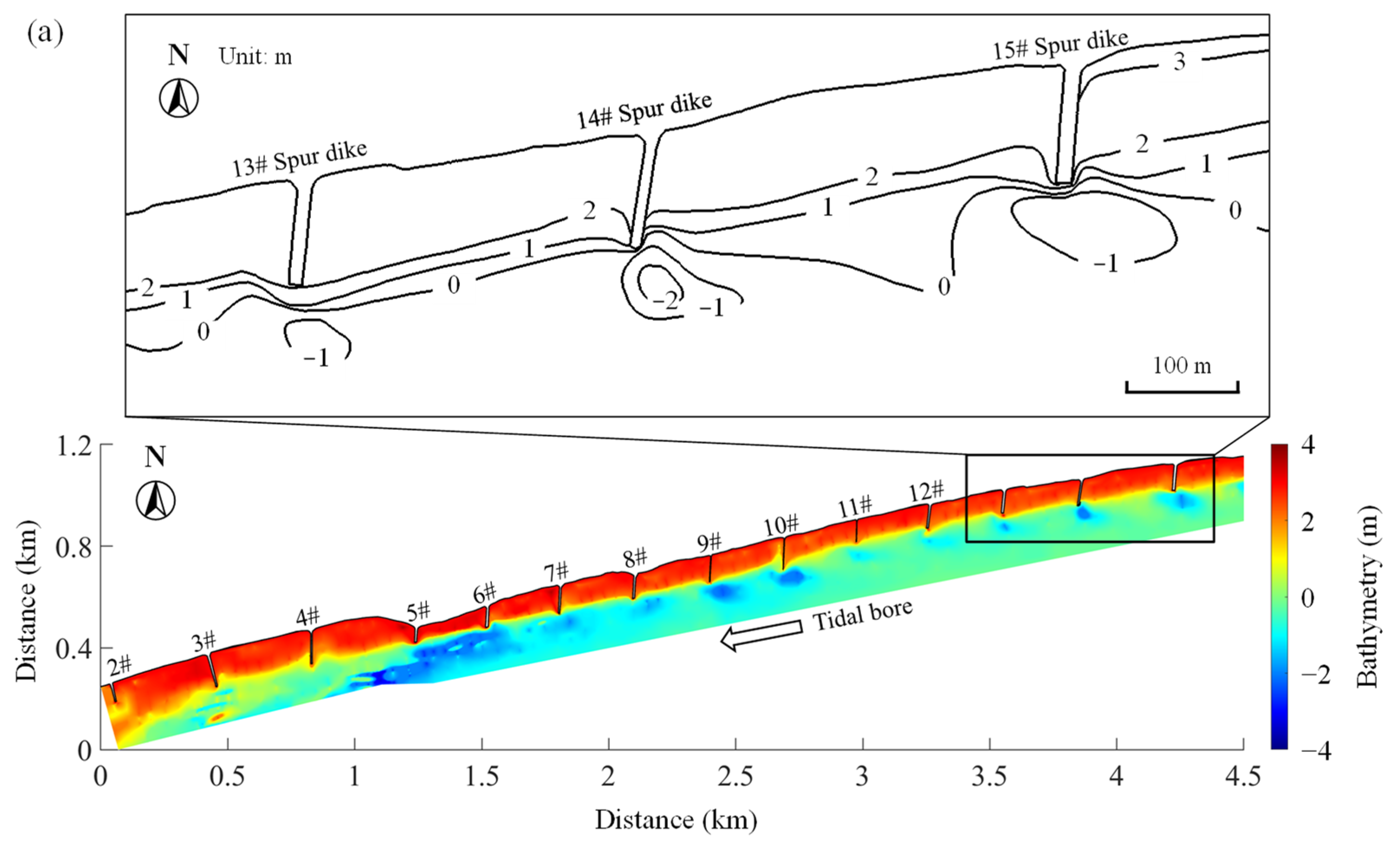
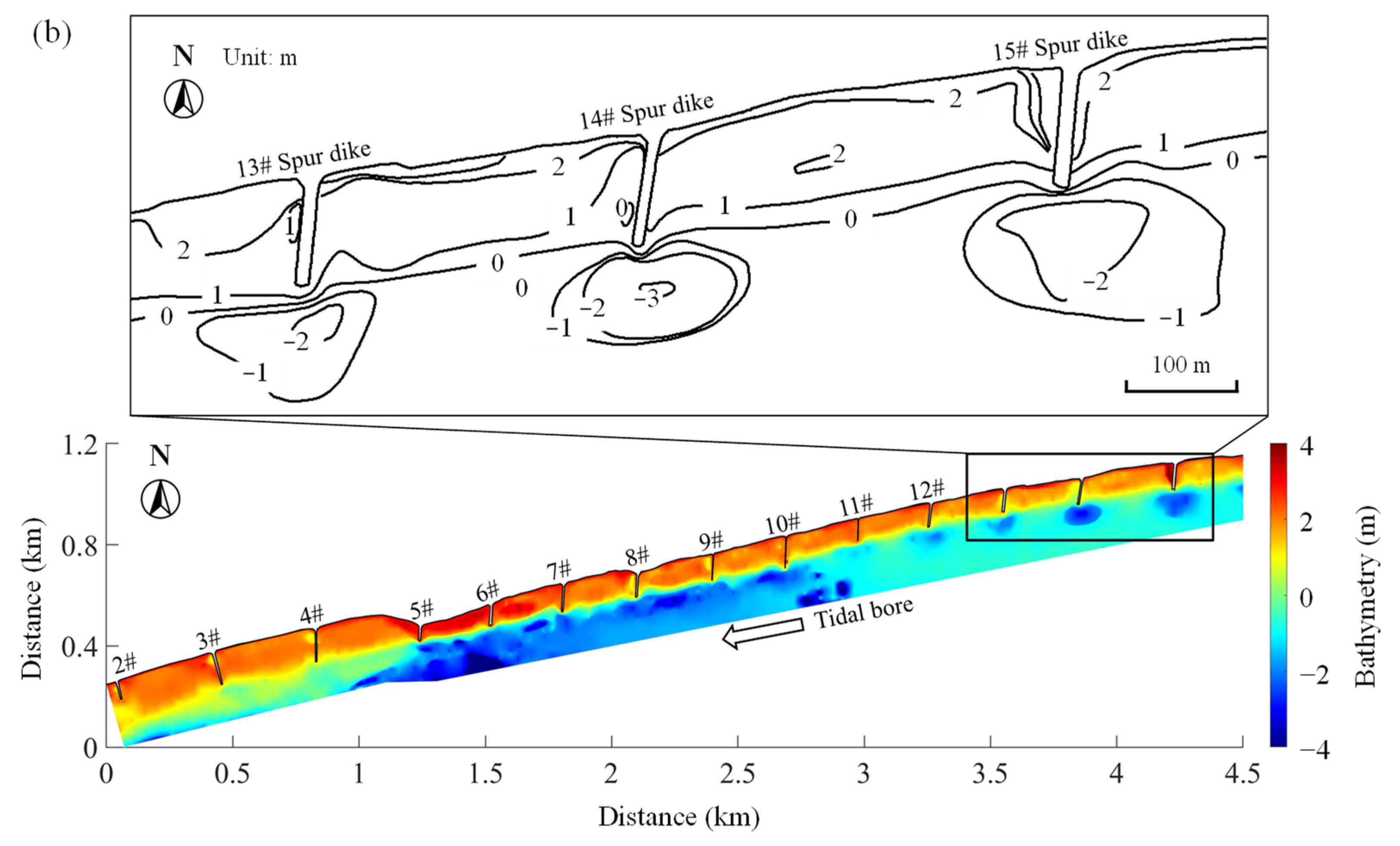
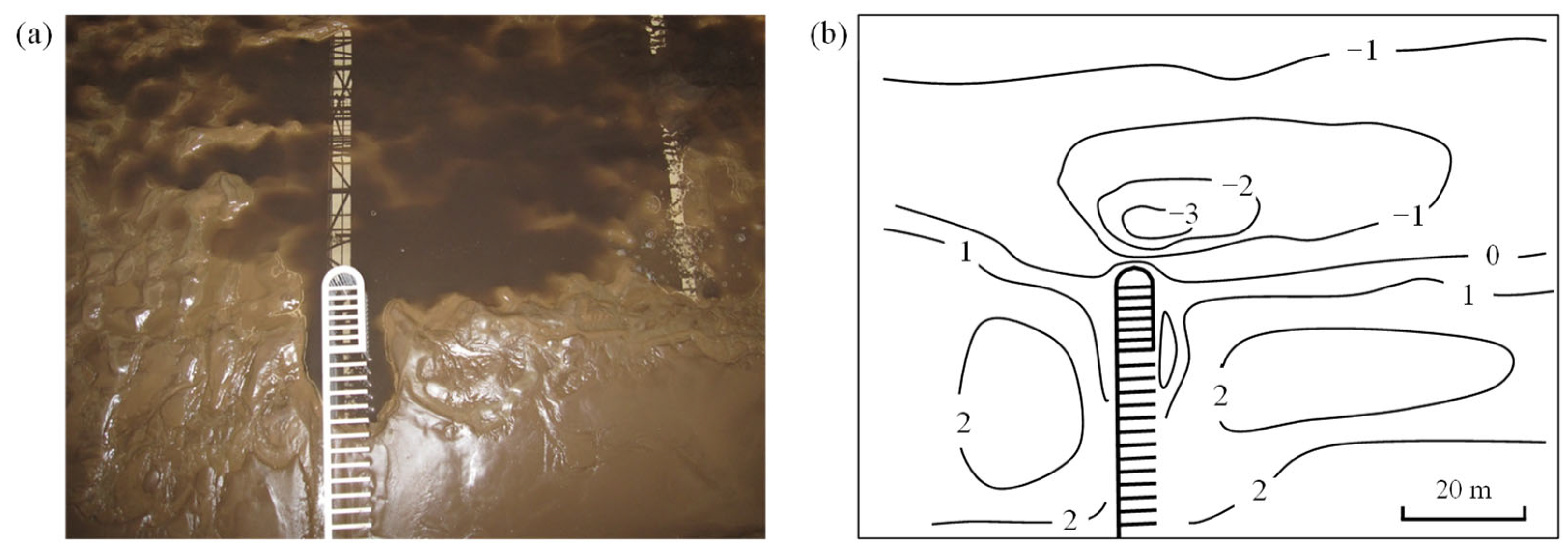
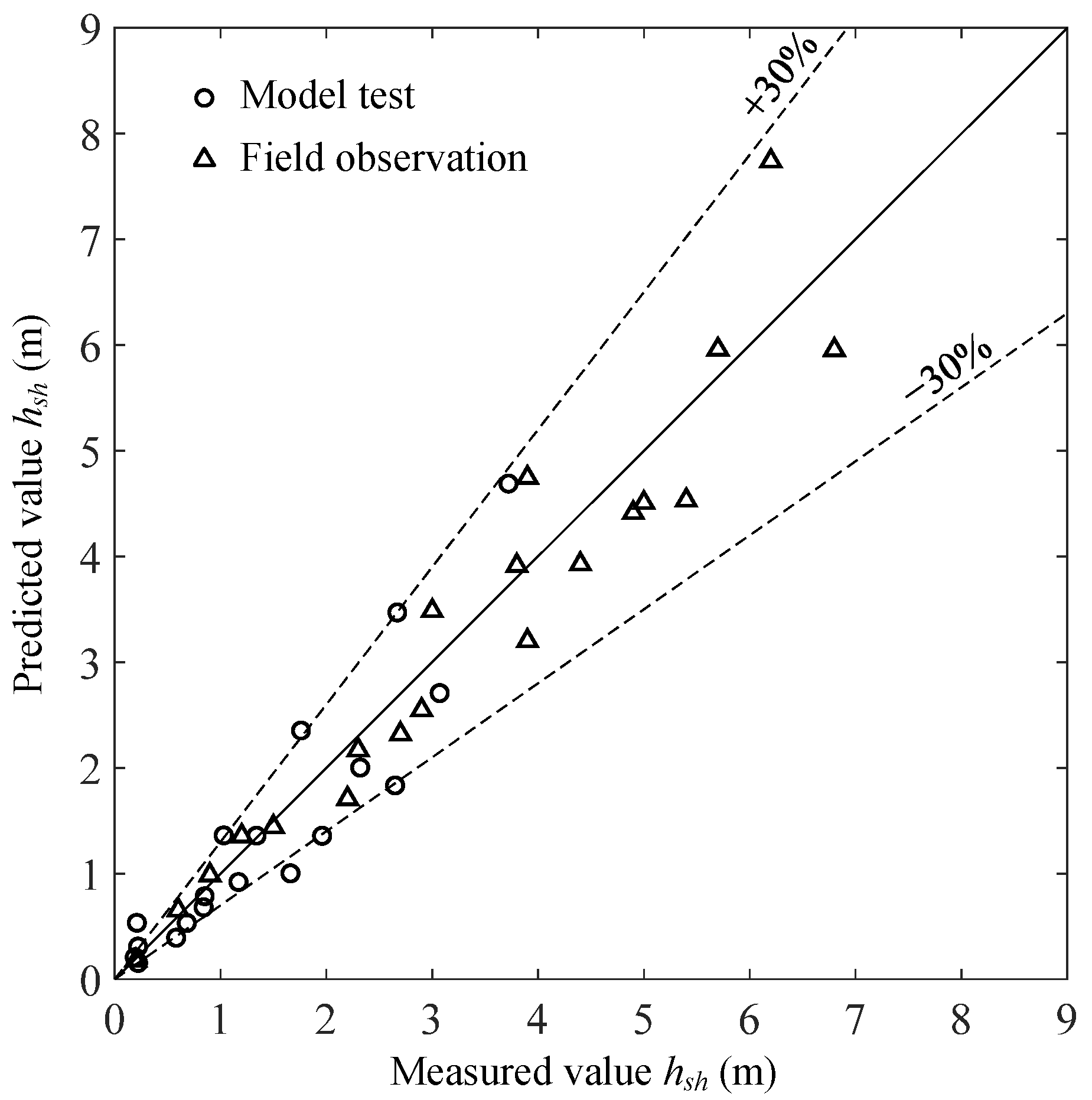
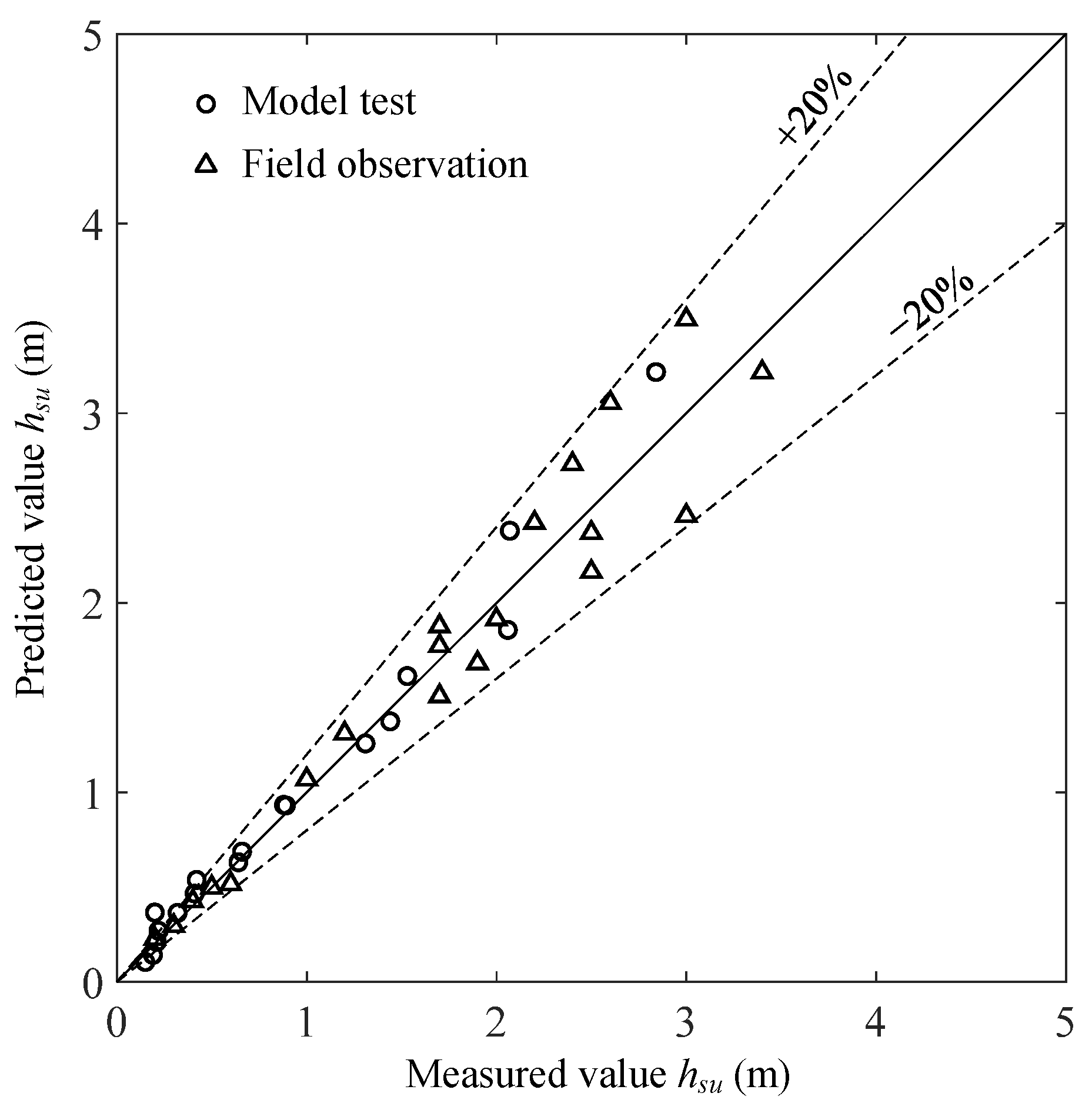

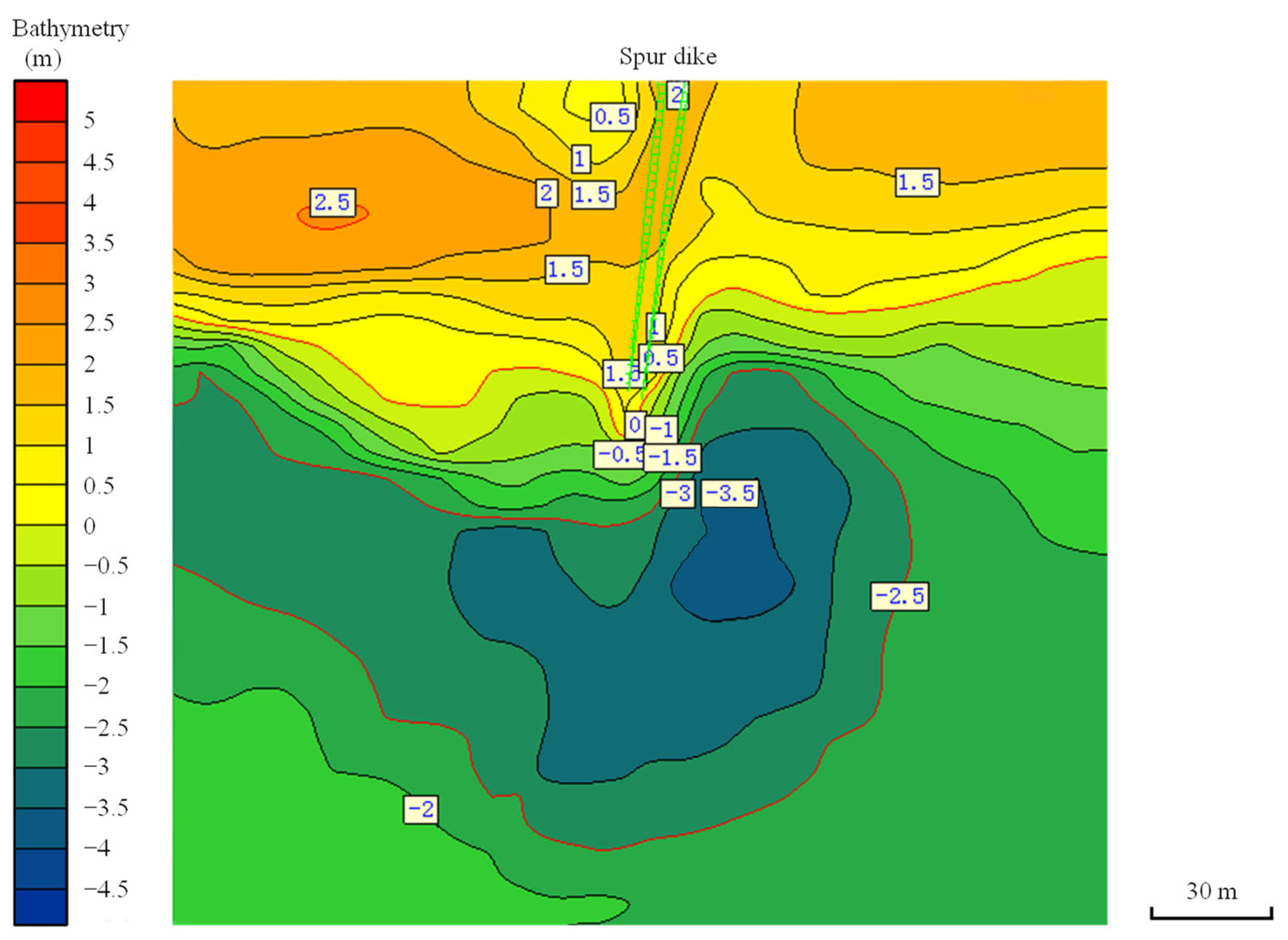
| Scales | Equations | Calculated Values | Selected Values |
|---|---|---|---|
| Horizontal length | λL | 80 | 80 |
| Vertical height | λH | 80 | 80 |
| Flow velocity | λu = λv = λH1/2 | 8.94 | 8.94 |
| Flow discharge | λQ = λL × λH3/2 | 57,243 | 57,243 |
| Current time | λt1 =λL × λu−1 | 8.94 | 8.94 |
| Incipient velocity | λV = λu | 8.94 | 8.94 |
| SSC 1 | λS = λρs/λ(ρs – ρ) | 0.22 | 0.38 |
| Morphological time 2 | λt2 = λt1 × λρ′/λS | 90 | 86 |
| No. | Initial Water Depth h (m) | Tidal Bore Height H (m) | Froude Number 1 Fr | Head Scour Depth hsh (m) | Upstream Side Scour Depth hsu (m) |
|---|---|---|---|---|---|
| 1 | 1.0 | 0.5 | 1.3 | 0.21 | 0.20 |
| 2 | 1.0 | 1.0 | 1.6 | 1.03 | 0.88 |
| 3 | 1.0 | 1.5 | 1.9 | 1.76 | 1.53 |
| 4 | 1.0 | 2.0 | 2.2 | 2.67 | 2.07 |
| 5 | 1.0 | 2.5 | 2.5 | 3.72 | 2.84 |
| 6 | 1.5 | 0.5 | 1.2 | 0.22 | 0.21 |
| 7 | 1.5 | 1.0 | 1.4 | 0.85 | 0.42 |
| 8 | 1.5 | 1.5 | 1.6 | 1.34 | 0.89 |
| 9 | 1.5 | 2.0 | 1.8 | 2.32 | 1.44 |
| 10 | 1.5 | 2.5 | 2.0 | 3.07 | 2.06 |
| 11 | 2.0 | 0.5 | 1.3 | 0.19 | 0.19 |
| 12 | 2.0 | 1.0 | 1.4 | 0.68 | 0.32 |
| 13 | 2.0 | 1.5 | 1.5 | 1.17 | 0.64 |
| 14 | 2.0 | 2.0 | 1.6 | 1.96 | 0.89 |
| 15 | 2.0 | 2.5 | 1.7 | 2.65 | 1.31 |
| 16 | 2.5 | 0.5 | 1.2 | 0.22 | 0.15 |
| 17 | 2.5 | 1.0 | 1.3 | 0.58 | 0.22 |
| 18 | 2.5 | 1.5 | 1.4 | 0.84 | 0.41 |
| 19 | 2.5 | 2.0 | 1.5 | 1.66 | 0.66 |
| 20 | 2.5 | 2.5 | 1.6 | 2.34 | 1.03 |
| No. | Scour Hole Location | Measured (m) | Estimated (m) | Error (m) |
|---|---|---|---|---|
| YC7# | Dike head | 5.3 | 4.6 | 0.7 |
| Upstream side | 1.4 | 1.0 | 0.4 | |
| HN16# | Dike head | 6.0 | 5.9 | 0.1 |
| Upstream side | 2.0 | 1.4 | 0.6 |
Publisher’s Note: MDPI stays neutral with regard to jurisdictional claims in published maps and institutional affiliations. |
© 2022 by the authors. Licensee MDPI, Basel, Switzerland. This article is an open access article distributed under the terms and conditions of the Creative Commons Attribution (CC BY) license (https://creativecommons.org/licenses/by/4.0/).
Share and Cite
Pan, D.; Li, Y. Tidal Bore Scour around a Spur Dike. J. Mar. Sci. Eng. 2022, 10, 1086. https://doi.org/10.3390/jmse10081086
Pan D, Li Y. Tidal Bore Scour around a Spur Dike. Journal of Marine Science and Engineering. 2022; 10(8):1086. https://doi.org/10.3390/jmse10081086
Chicago/Turabian StylePan, Dongzi, and Ying Li. 2022. "Tidal Bore Scour around a Spur Dike" Journal of Marine Science and Engineering 10, no. 8: 1086. https://doi.org/10.3390/jmse10081086
APA StylePan, D., & Li, Y. (2022). Tidal Bore Scour around a Spur Dike. Journal of Marine Science and Engineering, 10(8), 1086. https://doi.org/10.3390/jmse10081086






